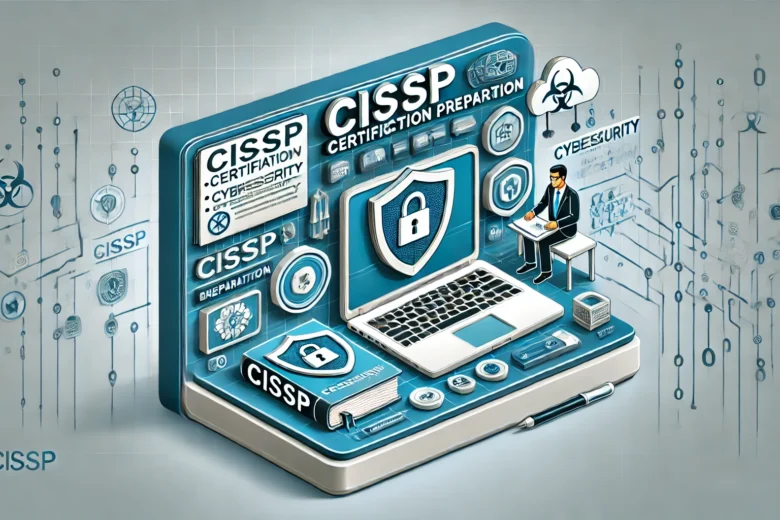In today’s rapidly evolving cybersecurity landscape, obtaining the CISSP certification is a significant achievement for IT professionals. The Certified Information Systems Security Professional (CISSP) credential is recognized worldwide and is highly respected among cybersecurity experts. It demonstrates your ability to design, implement, and manage a top-notch cybersecurity program.
This guide will walk you through everything you need to know about the CISSP certification, from understanding the exam structure to practical study tips that will help you pass confidently. You’ll also find personal insights and advice to motivate and prepare you for this challenging yet rewarding journey.
What is CISSP Certification?
The Certified Information Systems Security Professional (CISSP) is an independent information security certification overseen by the International Information System Security Certification Consortium, or (ISC)². It is designed to verify your expertise and skills across various areas in cybersecurity.
Note: CISSP is one of the most sought-after certifications in the cybersecurity industry, known for its thorough and extensive coverage.
Why Pursue CISSP Certification?
Career Advancement
- Leadership Roles: The certification opens doors to higher-level positions like Security Manager, Director, or CISO.
- Global Recognition: It proves your expertise worldwide, making you more marketable in the job market.
Higher Earning Potential
- Salary Boost: CISSP holders earn around 25% more than those without the certification.
- Competitive Edge: Having a CISSP sets you apart from other candidates.
Professional Growth
- Skill Enhancement: The certification deepens your knowledge of cybersecurity principles.
- Networking Opportunities: You’ll join a global network of over 140,000 certified professionals.
Statistic: According to the Global Information Security Workforce Study, CISSP-certified professionals earn an average salary of $120,000 per year.
Overview of the CISSP Exam
The CISSP exam measures your knowledge across eight different areas of cybersecurity.
Exam Format
- Number of Questions: 100-150 (Computerized Adaptive Testing – CAT)
- Duration: 3 hours
- Question Types: Multiple-choice and innovative questions
- Passing Score: 700 out of 1000 points
Important: The CAT format adjusts the difficulty based on your answers, providing a more accurate assessment of your skills.
Eligibility Requirements
To be eligible for the CISSP certification, you must meet the following criteria:
- Work Experience: At least five years of paid experience in two or more of the eight CISSP areas.
- Education Waiver: A four-year college degree or an approved credential can substitute for one year of experience.
Note: If you lack the required experience, you can still become an Associate of (ISC)² by passing the exam and then completing the experience requirements later.
Understanding the CISSP Domains
Knowing the eight areas is key to passing the exam.
- Security and Risk Management: Covers confidentiality, integrity, security governance, and compliance.
- Asset Security: Focuses on data management, security controls, and handling requirements.
- Security Architecture and Engineering: Involves secure design principles, models, and cryptography.
- Communication and Network Security: Addresses network design, secure channels, and components.
- Identity and Access Management (IAM): Covers access control, identification, and authorization.
- Security Assessment and Testing: Involves designing, performing, and analyzing security tests.
- Security Operations: Focuses on incident management, disaster recovery, and resource provisioning.
- Software Development Security: Deals with securing applications, development processes, and security measures.
Tip: Allocate your study time based on the importance of each area.
How to Prepare for the CISSP Exam
Create a Study Plan
- Assess Your Knowledge: Identify your strengths and weaknesses in each domain.
- Set a Timeline: Aim for 4-6 months of preparation.
- Daily Study Goals: Stick to a consistent study routine.
Understand the Exam Approach
- Think Like a Manager: Focus on strategies rather than technical details.
- Best Answer Strategy: Choose the most suitable answer among correct options.
Join Study Groups
- Online Communities: Participate in forums like Reddit’s r/CISSP.
- Local Study Groups: Join (ISC)² chapters for networking and group study.
Practice Exams
- Simulate Test Conditions: Time yourself to mimic the actual exam.
- Review Your Mistakes: Learn why you got certain answers wrong.
Important: Regular practice improves your familiarity with the exam’s format.
Recommended Study Resources
Official (ISC)² CISSP Guide
- Description: The official book covers all eight domains.
- Recommendation: Use it as your main study resource.
Popular Study Guides
- Books:
- “CISSP All-in-One Exam Guide” by Shon Harris
- “CISSP Official Study Guide” by James M. Stewart
- Online Courses:
- (ISC)² CISSP Training
- Udemy, Coursera, and Cybrary courses
Tip: Use multiple resources to cover all aspects of the exam.
Effective Study Techniques
Note-Taking
- Summarize Key Points: Write down important information in your own words.
- Flashcards: Use for memorizing terms and concepts.
Mind Mapping
- Create Visual Diagrams: Map out related ideas and concepts.
- Domain Breakdown: Organize each domain visually to understand the topics better.
Teach Back Method
- Explain Concepts: Teach the material to someone else to reinforce your learning.
- Identify Weaknesses: Discover areas where you need more focus.
Time Management
- Pomodoro Technique: Study for 25 minutes and take 5-minute breaks.
- Avoid Burnout: Take regular breaks to keep your mind fresh.
Important: Quality of study is more important than the number of hours spent.
Strategies for Exam Day
Before the Exam
- Rest Well: Get at least 7-8 hours of sleep.
- Eat a Healthy Meal: Maintain energy levels.
- Arrive Early: Give yourself time to settle in.
During the Exam
- Manage Your Time: Spend about 1.2 minutes per question.
- Read Questions Carefully: Look for keywords like “BEST” or “MOST.”
- Eliminate Wrong Answers: Narrow down your choices.
Tip: Stay calm and confident.
What to Do After the Exam
Getting Results
- Immediate Feedback: You’ll get provisional results at the test center.
- Official Confirmation: (ISC)² will send your final results via email.
Endorsement Process
- Complete Within 9 Months: Submit your application on the (ISC)² website.
- Endorser: A certified professional will verify your work experience.
Maintaining Your CISSP Certification
- Earn 120 CPE Credits: Complete 40 credits annually over three years.
- Pay the Annual Fee: $125 per year to maintain your certification.
Important: Stay active in the field to keep your skills and certification current.
Personal Journey: From Candidate to CISSP
The Decision to Pursue CISSP
Choosing to pursue the CISSP certification was a turning point in my career. I knew it would open doors and add value to my professional life.
Overcoming Challenges
- Time Management: Balancing work, study, and life was tough but manageable.
- Information Overload: Breaking the content into small sections helped.
The Exam Day Experience
I was nervous but focused. After the exam, I was relieved to see “Congratulations.”
Common Obstacles and Solutions
Content Overload
Solution: Divide the material into smaller sections.
Technical vs. Managerial Thinking
Solution: Practice focusing on policies and high-level concepts.
Frequently Asked Questions
Can I take the CISSP exam without the required experience?
Yes, you can become an Associate of (ISC)² and gain the experience later.
How hard is the CISSP exam?
The exam is challenging due to its wide scope. Preparation is key.



